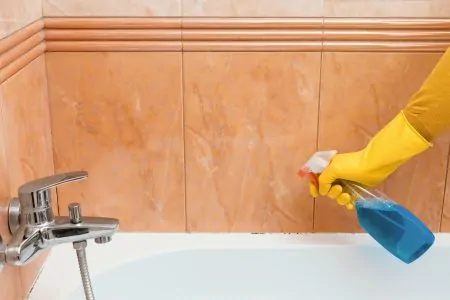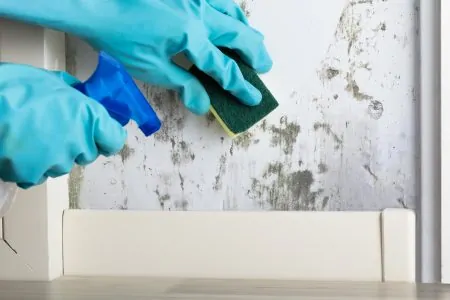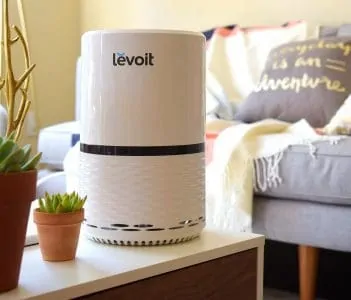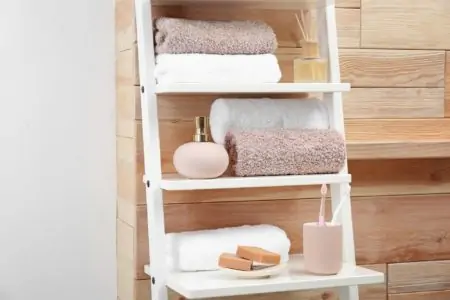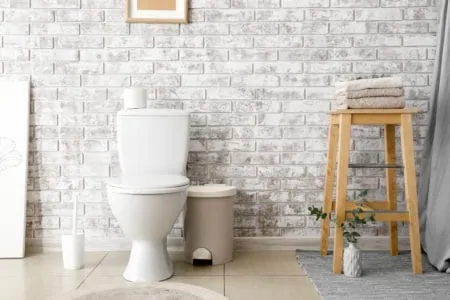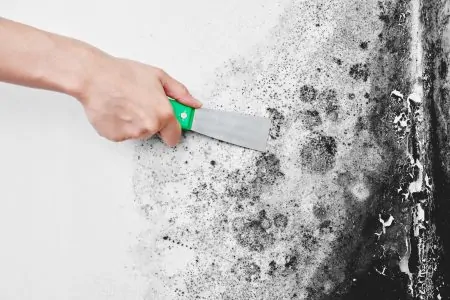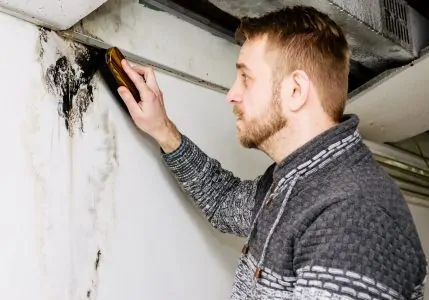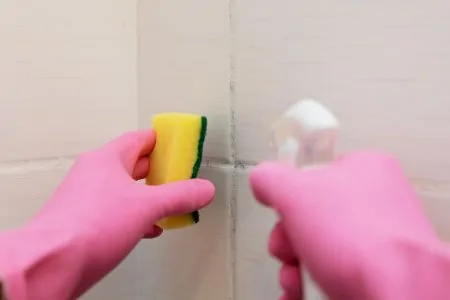Mold is a fungus that can live anywhere with moisture, warmth, and nutrition. Due to the optimal bathroom conditions, it’s a very common area to find mold growth.
Considering the potential health effects of mold, we like to keep our homes free from it. But how do you clean mold in bathrooms? To effectively remove it, you must kill it and prevent new mold from growing.
We’ll show you the best method for removing mold from your bathroom, so it feels less grimy and more spa-like.
Key Takeaways
- Use mold-killing solutions like borax and water, vinegar, or bleach to clean mold from bathroom surfaces.
- To clean mold from showers and bathtubs, apply the chosen solution, scrub with a brush, and rinse the area.
- For moldy shower curtains, use baking soda or bleach in the washing machine along with towels to remove mold.
- To remove mold from bathroom walls, floors, and grout, use hydrogen peroxide, OxiClean, baking soda, or chlorine bleach, and consider re-sealing grout to prevent future mold growth.
How to Make a Mold-Busting Solution
You can use many things to clean mold, but not everything will kill it. As we mentioned above, if you want to get rid of mold for good, you must kill and prevent it from recurring.
Here are a few homemade solutions that work effectively at removing mold:
Borax and Water
Borax is a natural fungicide and is excellent for fighting off mold (1).
Combine one cup of borax with one gallon of water. Then give it a good mix until the powder is dissolved. Pour the mixture into a clean spray bottle.
Not only will borax kill and remove mold, but it will also prevent new growth. For this reason, you don’t need to rinse the solution off once you’re done.
However, if it’s filthy, rinse the area and apply some more once you’re done.
Safety Precautions
Vinegar
Vinegar is one of our go-to cleaning solutions for every area of our home. It’s affordable, efficient, and non-toxic — perfect for parents and pet owners.
Keep the vinegar undiluted for the best results. Fill a spray bottle with vinegar and apply directly onto the moldy area.
Tackle Vinegar Odor
Bleach
Bleach is one of the most effective ways to kill mold. However, we like to use it as a last resort due to the toxicity of the substance.
Bleach is toxic and can cause eye, skin, and lung irritation. You must keep the area clear from children and pets and the room well-ventilated. Always wear protective gear such as gloves and preferably a mask and goggles (3).
You can create a mold-killing solution using one part bleach to 10 parts water. Mix it in a spray bottle for easy application. Spray directly onto the moldy area and allow it to sit for a few minutes. Keep the area closed off from pets and children.
Don't Mix Bleach
How to Clean Mold in Bathrooms
We’ll walk you through how to remove mold from specific areas of the bathroom. This includes the shower, the shower curtain, the bathtub, the walls, the floor, and the ceiling.
Removing Mold From Shower
The shower is a prime spot for mold growth; the often moist and humid space provides precisely what mold needs to grow. You might find mold in the drain, grout lines, and caulk.
1. Select Your Mold-Killing Solution
We highly recommend that you choose one of the solutions we mentioned above. Inspect the shower area to know where the mold is hiding.
Check the drain, grout, and caulk — consider how much mold is present. If it’s only a small amount, use a milder solution such as vinegar. However, if the mold is more severe, consider using bleach or borax.
2. Apply the Solution
Spray the solution directly onto the moldy area. We also like to spray the area around it to ensure all spores and traces are killed.
Allow your solution to sit on the moldy area for 10 to 15 minutes or less if using bleach (five to 10 minutes).
Shower caulk is a little more tricky to clean than other shower parts. For this, make a paste of baking soda and bleach.
Add a generous amount of baking soda to a container. Slowly add bleach until it forms a paste. Apply the paste to the moldy area and cover with plastic wrap. It might be tricky, but do what you can.
Leave the paste on the mold for up to two hours. Remove the plastic and scrub with a brush. Rinse the area well, and repeat the process if there’s still mold.
3. Scrub
Use a stiff nylon brush to scrub the mold off. It should be loose and easy to remove. We recommend using a grout brush or an old toothbrush for smaller areas.
4. Rinse
Use the showerhead to rinse off the mold and solution. The area should now be mold-free and clean.
However, if you still see traces of mold, repeat the process. If you used a milder solution, such as vinegar, and the mold is still present, try bleach instead.
Removing Mold From Shower Curtain
You might feel like your shower curtains are beyond repair when discovering mold; however, you can save them. Here’s how to clean shower curtains:
Baking Soda
Remove your shower curtain and place it in the washer along with some bath towels. The towels will prevent the curtain from crinkling, but they will also help to scrub the shower curtains.
Add your usual laundry detergent to the machine along with half a cup of baking soda. Start the machine as you normally would, but add half a cup of vinegar when it gets to the rinse cycle.
When the cycle is finished, hang the curtain to dry — preferably in the sun, as UV rays also kill mold.
Bleach
Make a solution of 1/2 cup bleach and 1/4 cup of laundry detergent in a bucket. Fill the bucket with water and put it aside.
Remove the shower curtain and place it in the washing machine along with two towels.
Start the regular cycle and add the bleach solution once the machine is full of water. Adding the solution when the machine is empty will increase the chances of damaging the towels.
Once the washing machine is finished, hang the curtain out to dry.
Repeat If Necessary
Removing Mold From Bathtub
Soap scum, grime, bacteria, and dead skin cells are often gathered at the bottom of a bathtub. This creates the optimal conditions for mold to grow since it provides abundant nutrients and moisture.
But bathing in a moldy bathtub isn’t ideal, so we’re here to remove it. We like to use borax for the bathtub because you can leave it in the tub until the next time you use it.
1. Apply
Apply the borax and water solution using a spray bottle. Make sure you’re covering all the mold — pay close attention to the edges where the wall meets the tub. The drain might also have a significant amount of mold.
Allow the borax to sit for 10 to 15 minutes.
2. Scrub
Because we’re working on a bathtub, we need to avoid scratching the surface. Don’t use stiff brushes or other abrasive tools such as steel wool. Opt for a soft-bristled brush or a two-sided sponge.
3. Rinse
If there’s a lot of mold, rinse the area after scrubbing. Consider reapplying the borax solution and leaving it in the tub until it dries. This will help to kill any leftover mold or spores.
Removing Mold From the Bathroom Walls and Floor
Most homeowners have tiles installed in the bathroom. These may be ceramic, porcelain, or even natural stone. No matter which floors or walls you have in your bathroom, mold is possible.
You’ll likely find mold growing in the grout lines since this is a porous surface — unless it’s sealed. Mold can begin to grow within unsealed grout, and it will often leave nasty stains behind.
We have a few effective methods you can try out, but before you do, start with the following steps:
1. Scrape
Scrape off as much of the mold as you can. This will make your work easier and less messy. You can also use a stiff brush to scrub the mold away.
2. Steam
If you have a steam cleaner, use it before applying any cleaning solution. Attach a small brush, such as the one for grout lines. Steam the moldy areas thoroughly to kill and remove the mold.
A steam cleaner will deliver steam at extremely high temperatures (around 200 degrees Fahrenheit). This will effectively kill actively growing mold and spores. The steam will also effectively penetrate the grout, removing embedded mold.
Keep In Mind For Sealed Grout
3. Wipe
Use an old towel or cloth to wipe the entire area since there will be loose mold.
If there’s still mold present, try one of the following methods:
Hydrogen Peroxide
Hydrogen peroxide is a mild form of bleach. It effectively removes mold stains on colored grout and tiles where chlorine bleach might damage the surfaces.
Use the hydrogen peroxide undiluted by pouring it into a dark spray bottle. You can also attach a spray applicator to the hydrogen peroxide bottle itself.
Hydrogen peroxide will lose its potency when exposed to light. Therefore, it should be kept in a dark-colored container.
Allow the hydrogen peroxide to sit for 15 minutes before scrubbing the area with a brush. Rinse well with water and wipe to dry.
OxiClean
OxiClean contains oxygen bleach and is effective at removing mold and stains. Oxygen bleach is also preferred if you have a septic system as it’s less harmful to the environment.
Fill a spray bottle three-quarters of the way with water and add one or two tablespoons of oxygen bleach or OxiClean. Give it a good shake to combine well.
Apply the solution directly onto the molded area and leave it for 10 minutes. Scrub with a stiff brush and rinse well — finish off by wiping the area with a cloth.
Baking Soda
Baking soda is an excellent natural option when cleaning mold from walls, floors, and grout. For this method, we’ll make a paste using equal amounts of baking soda and water. The paste will be thick enough to stick to a vertical surface.
Apply the paste using an old toothbrush or your fingers. Leave it to sit for 10 minutes, then scrub with a toothbrush or a grout brush. Rinse with water to remove excess paste.
Chlorine Bleach
If you still see stains from the mold or the stains are severe from the beginning, try chlorine bleach. Make the same solution as we mentioned earlier — one part bleach to 10 parts water.
Apply it to the entire area and allow it 10 minutes to work. Then scrub with a stiff-bristled brush.
If the stains are still there, soak a few paper towels in bleach and apply them to the area. This might be difficult on a vertical surface, but it should stick. Allow it to sit until the stains have faded. Rinse well to remove the bleach.
Since bleach is toxic, keep the room well-ventilated. You should also wear gloves to protect your hands.
Do A Test
4. Replacing Grout
It might be best to replace the grout if the mold has left stains that won’t budge. This doesn’t take long, and you can even do it yourself.
Remove the old grout using a flat head screwdriver. You can buy grout from your local hardware store — mix it as directed and apply.
5. Sealing Grout
If you successfully remove mold stains from the grout, consider re-sealing to prevent new stains. You can do this yourself; grout sealants are available at any hardware store. We recommend that you seal new grout to keep moisture and mold out.
Removing Mold From Bathroom Ceiling
How you remove mold from your bathroom ceiling depends on the surface. You’ll likely need to replace the moldy part if it’s a porous material like wood, drywall, or popcorn.
Mold in the ceiling is often caused by poor ventilation or water leaks. If you have pipes in the ceiling, consider checking to see if there’s a leak. You must also ensure that your bathroom fan is working correctly.
If your ceiling is made of a non-porous material, you can try the following to remove the mold:
1. Prepare the Bathroom
Start by opening a window and turning the fan off. Protect yourself by wearing gloves, goggles, and preferably a mask.
Use a step stool, chair, or ladder to reach the ceiling. If the ceiling is painted, use a scraper to remove the paint from the molded area.
2. Mix a Solution
In a container, add two cups of hot water, a quarter of a cup of vinegar, and two tablespoons of borax. Give it a good mix to dissolve the powder.
3. Apply
Dip a two-sided sponge in the solution and apply it to the area. Use the rough side to scrub the mold away. Have a clean, damp cloth at hand to rinse every once in a while.
Repeat the process until the mold is gone. You may need to replace the solution if it becomes dirty.
4. Reapply
When the area is clean and mold-free, spray the solution onto the entire area. Allow the borax and vinegar to dry on the ceiling; this will help to kill any leftover mold and spores.
5. Repair the Ceiling
When all mold is gone, sand the ceiling and repaint it. Use a waterproof mold-resistant paint to prevent mold and water damage in the future.
FAQs
Creating a Mold-Free Bathroom
Discovering mold in the bathroom can be disheartening. Because there’s often a lot of moisture within the bathroom, it can be tricky to keep mold away.
However, you can prevent mold by keeping the bathroom well-ventilated and wiping the floor, shower, and tub after cleaning.
We highly suggest that you try a milder method before reaching for bleach. Bleach might be useful, but things like borax, vinegar, or baking soda are just as effective.
